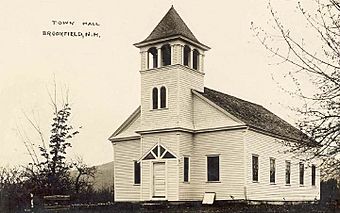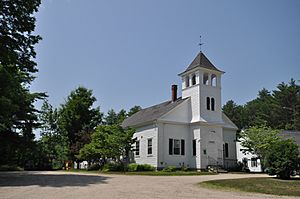Brookfield Town Hall facts for kids
Quick facts for kids |
|
|
Brookfield Town Hall
|
|

Postcard view, c. 1915
|
|
| Location | NH 109, Brookfield, New Hampshire |
|---|---|
| Area | 0.5 acres (0.20 ha) |
| Architect | Multiple |
| Architectural style | Late Victorian |
| NRHP reference No. | 85001189 |
| Added to NRHP | June 6, 1985 |
The Brookfield Town Hall is a very old and important building in Brookfield, New Hampshire. It's located right on New Hampshire Route 109. Since it was built way back in 1822-1823, it has been the main meeting place for the town. It's the only big public space where people in Brookfield can gather. Over the years, it got some cool updates, especially around 1907-1908, which gave it a mix of different styles. Because of its history and unique look, the building was added to the National Register of Historic Places in 1985.
What is a Town Hall?
A town hall is like the main office for a town's government. It's where important meetings happen and where people can go for town services. The Brookfield Town Hall has been serving its community for a very long time.
A Look at the Building
The Brookfield Town Hall is a wooden building with one and a half stories. It has a pointed roof and its outside walls are covered with clapboards, which are long, thin pieces of wood. At the back, there's a smaller section that used to be a one-room schoolhouse.
The front of the building has a cool tower that sticks out. This tower goes up to an open belfry, which is where a bell would be. The top of the tower has a pyramid-shaped roof. The middle part of the tower is decorated with fancy cut shingles. The belfry section has columns at the corners and arched openings.
The main door to the town hall is at the bottom of this tower. Above the door, there's a simple, decorative wooden piece.
A Long History
The town hall was finished in 1823, after the town decided to build it the year before. At first, the building was also used for church services, but that doesn't happen much anymore.
The building has been updated a couple of times. In the 1870s and 1880s, the old box pews (like small enclosed seating areas) were taken out. They were replaced with settees, which are like long benches. The pulpit, where a speaker would stand, was also replaced with a platform.
Spaces were also created for the town's leaders, called selectmen, to meet. Another room was made for the town library, and later it became a kitchen.
In the early 1900s, someone gave a bell to the town. This led to building the Victorian-style tower and belfry you see today. The inside of the building was also slowly changed to match the Victorian style. It's pretty special that Brookfield updated its old town hall instead of building a brand new one, which many other towns did. Since then, only small changes have been made to the building.




